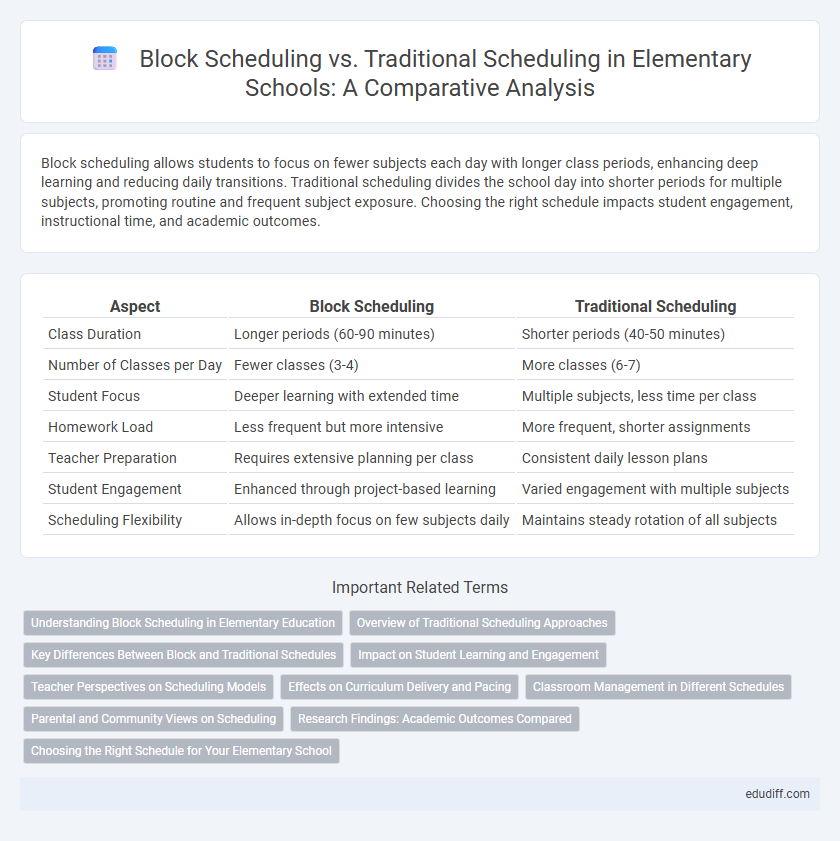Block scheduling allows students to focus on fewer subjects each day with longer class periods, enhancing deep learning and reducing daily transitions. Traditional scheduling divides the school day into shorter periods for multiple subjects, promoting routine and frequent subject exposure. Choosing the right schedule impacts student engagement, instructional time, and academic outcomes.
Table of Comparison
| Aspect | Block Scheduling | Traditional Scheduling |
|---|---|---|
| Class Duration | Longer periods (60-90 minutes) | Shorter periods (40-50 minutes) |
| Number of Classes per Day | Fewer classes (3-4) | More classes (6-7) |
| Student Focus | Deeper learning with extended time | Multiple subjects, less time per class |
| Homework Load | Less frequent but more intensive | More frequent, shorter assignments |
| Teacher Preparation | Requires extensive planning per class | Consistent daily lesson plans |
| Student Engagement | Enhanced through project-based learning | Varied engagement with multiple subjects |
| Scheduling Flexibility | Allows in-depth focus on few subjects daily | Maintains steady rotation of all subjects |
Understanding Block Scheduling in Elementary Education
Block scheduling in elementary education organizes the school day into fewer, longer class periods, allowing teachers to engage students in more in-depth lessons and hands-on activities. This approach supports improved focus and retention by reducing transitions and providing extended time for subjects such as math, reading, and science. Research indicates that block scheduling can enhance student comprehension and promote active learning in elementary classrooms.
Overview of Traditional Scheduling Approaches
Traditional scheduling in elementary schools typically follows a fixed daily timetable where subjects are assigned specific time slots. This method often segments the day into short periods, allowing students to switch between multiple subjects such as math, reading, and science. While it provides consistency, traditional scheduling can limit flexible learning opportunities and longer instructional blocks.
Key Differences Between Block and Traditional Schedules
Block scheduling organizes the school day into longer class periods, typically 90 minutes, allowing for in-depth lessons and interactive activities, whereas traditional scheduling uses shorter periods, usually around 45 minutes, with more classes daily. Block schedules reduce the number of daily transitions, minimizing downtime and increasing focus, while traditional schedules offer more frequent subject exposure but may lead to rushed lessons. Teachers in block schedules can plan extended projects and labs, enhancing experiential learning opportunities compared to the more segmented approach of traditional schedules.
Impact on Student Learning and Engagement
Block scheduling in elementary schools allows longer instructional periods, enabling deeper exploration of subjects and hands-on activities that increase student engagement. Traditional scheduling, with shorter, more frequent classes, often limits the time for immersive learning but provides regular breaks that can help maintain attention. Research suggests block scheduling can improve academic outcomes and engagement by reducing transitions and fostering more meaningful interactions between teachers and students.
Teacher Perspectives on Scheduling Models
Teachers find block scheduling offers more uninterrupted time to engage students deeply in subjects, enhancing lesson quality and student understanding. Traditional scheduling provides consistent daily routines, helping teachers manage diverse subjects and classroom tasks systematically. Educators often prefer block scheduling for its flexibility, though some appreciate traditional models for predictable pacing and easier daily planning.
Effects on Curriculum Delivery and Pacing
Block scheduling in elementary schools allows for longer class periods, enabling teachers to cover subjects in greater depth and incorporate more hands-on activities, which can enhance student engagement and understanding. Traditional scheduling, with shorter, more frequent periods, often requires faster pacing and segmented lessons, potentially limiting the depth of curriculum coverage. The extended time in block schedules facilitates more flexible and comprehensive curriculum delivery, promoting better retention and mastery of concepts compared to traditional schedules.
Classroom Management in Different Schedules
Block scheduling allows longer class periods, giving teachers more time for in-depth activities and classroom management. Traditional scheduling has shorter, more frequent classes, requiring quick transitions and efficient behavior management. Effective classroom management adapts to the schedule type to maintain student engagement and minimize disruptions.
Parental and Community Views on Scheduling
Parents and community members often prefer block scheduling in elementary schools because it allows for longer, more focused learning periods that support deeper understanding and reduce daily transitions. Traditional scheduling is valued for its predictability and routine, which many parents believe helps young children feel secure and manage their day effectively. Surveys indicate that community support tends to increase when schools communicate the benefits and address concerns about changes in scheduling formats.
Research Findings: Academic Outcomes Compared
Research indicates that elementary students in block scheduling programs often demonstrate improved academic outcomes, including higher test scores and enhanced retention of material, compared to those in traditional scheduling. Studies highlight increased student engagement and deeper understanding of subjects due to extended class periods in block schedules. However, some research suggests that the benefits may vary depending on implementation quality and subject areas.
Choosing the Right Schedule for Your Elementary School
Block scheduling in elementary schools allows longer periods for deeper engagement and hands-on activities, fostering better understanding and retention compared to traditional scheduling. Traditional schedules, with shorter, multiple periods, can offer more frequent breaks and diverse subject exposure, beneficial for younger students' attention spans. Selecting the right schedule depends on student needs, curriculum goals, and teacher flexibility to support effective learning outcomes.
Block Scheduling vs Traditional Scheduling Infographic

 edudiff.com
edudiff.com